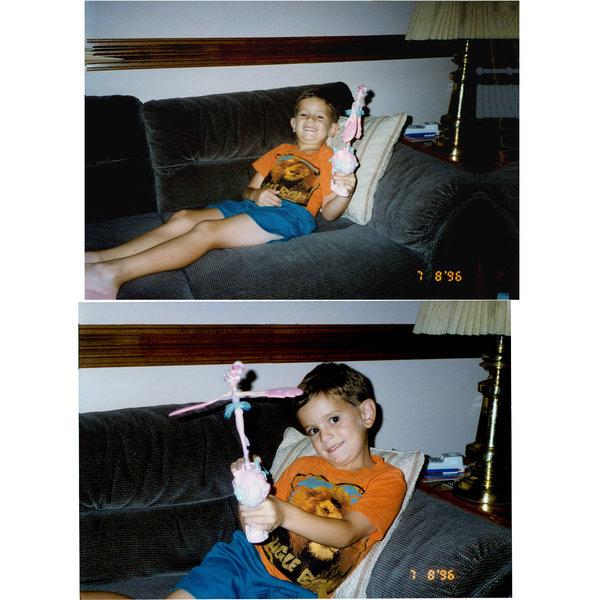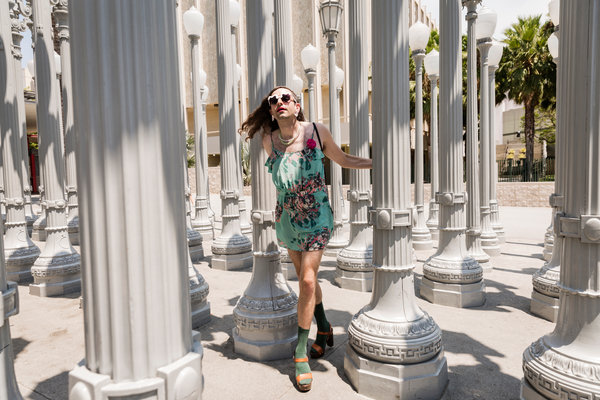Two years ago, I spent Christmas with my family in North Carolina with a mission: to digitize a dozen or so of my favorite childhood photos.
Looking through childhood photos is fun for some people. “Look back on old memories! Revel in the past!”
But if you’re like most people, looking through childhood photos is an exercise in nostalgia, often with a tinge of melancholic regret. Also: It’s a logistical nightmare. In my case, I severely underestimated just how many photographs my parents had in the house. Stacked one on top of another, in the living room of the house I grew up in, the boxes could have easily reached the ceiling.
I wanted to find these photos because I was writing a memoir. A memoir about coming into my own as a gender nonconforming person. As I began thinking about those first chapters, about delving into my childhood, it became clear just how little I remembered.
It’s not that I’d blocked it out — I have some memories. I remember that, from the earliest age, I was who I was. What I struggle to remember is what it felt like to be that person.
And so my task was less perusing and more excavating. I became an archaeologist of sorts — hopeful to uncover ancient shards of my childhood gender and piece them back into the whole. Who was I before the world interfered? Who was I before my gender was shut down? I hoped that the photos could show me.
As I flipped through photos that hadn’t seen the light of day in two or more decades, the dust was everywhere. Eyes watering, nose itching, a sneezing mess, I rifled through print after print.
Then I found it. My favorite childhood photo, one that I remember seeing years ago.
Holding a bouquet of fake flowers, a 3-year-old me stands in a tutu and a floppy hat. I’m planted in the middle of my neighbor’s living room, adjacent to the ottoman, posed for a picture in front of the TV set.
As I turned the photograph over in my hands — still glossy, vibrant, remarkably well-preserved — I found myself inundated with emotion. But it was the grief, not the reminiscence, that surprised me.
On the surface, the photo reveals what was readily apparent to everyone who knew me at that age: that I was a gender nonconforming child. As a young boy, my femininity was an open secret; understood by everyone, discussed by none. In carefree moments, it showed itself abundantly — I’d frolic with the girls during playtime, reach for the sparkliest fabrics during dress up and joyfully twist my hips during dance class.
Sitting on the floor in the house I grew up in, I placed the photo delicately in the “to be scanned” pile. This one was a keeper, for sure. It told exactly the story I needed. See, world? Even from an early age, Jacob has always been this way. I started to move on to other photos, but something stopped me.
I picked the photo back up, taking a second look. In my haste, I’d missed the forest for the trees. Yes, my outfit is adorable. Yes, the photo illustrates that my love for tulle began at a very early age. Yes, it is a charming relic of my sissy heritage. But once you get past the outfit, a much more significant detail emerges: the expression.
The face I’m making confounds me. Surely, I was overjoyed to be wearing that skirt. As a trans child bursting with curiosity about my gender, I took any chance I could get to sport flowing fabric, don flowers and wear extravagant hats — the kind I wasn’t usually allowed to wear at home. In this particular photograph, I was doing all three. So why wasn’t I smiling?
Looking at it now, I have a guess as to what my blank expression was reflecting: eyes wide, corners of mouth turned ever so slightly downward, as if whatever emotion I had the moment before had been vacuumed out.
Even by the age of 3 or 4, I knew that the way I expressed myself was unacceptable. I did not know the terms “transgender” or “genderqueer” or “nonbinary,” but as a young boy, I knew that I was not allowed to be “girly.” I could not wear pink, prance in dresses, hold my hips just so, or flounce about in sparkles. When I wandered to the Barbie aisle in the toy store, I would be subtly steered back to the Legos. I knew, even then, that there were parts of myself I needed to hide.

CreditJacob Tobia
There were exceptions to this rule. There were a few safe zones in my childhood, places where I could break the mold without fear of retribution. Like when I was at my next-door neighbor’s house, away from my parents. It was safe there.
Or when my dad was away on a business trip and my older brother was off at school and it was just my mom and me. Then I could play. In the cocoon of that privacy, for a few precious moments, I could transform. I could watch girly TV shows, color pictures of princesses or unicorns, draw pink polka-dots all over. On neighborhood walks with my mom, we’d stroll at half-pace so I could pick her miniature bouquets of wildflowers. Just me and her, I could let my femininity fly.
This photograph came from one such moment, a girls-only birthday party next door that my mother (miraculously) arranged for me to attend. None of the neighborhood dads were there, just me and the girls and the moms. As my mother tells it, I dressed up and ran around in the backyard, carefree for the afternoon.
But then my mom decided to take my picture. Looking at my face in the photograph, it’s clear that even then I knew the stakes. Wearing a tutu in relative privacy was one thing. Being photographed in a tutu, creating evidence of my transgression (pun intended) was quite another. What if the boys from the neighborhood saw the photo? What if my dad saw it? Or my brother?
Studying the photo, I recognize what made me take that second look. I am a scared child in a gorgeous outfit, and the grief is overwhelming.
I wish I could protect the child in that photo. I wish I could alleviate their anxiety and pain.
While it was scary to be photographed in a tutu at the time, these days I realize how important it was that my mom took the time to document my childhood gender creativity.
When I asked my mom what compelled her to take the photo, she said it was simply because I was “being adorable.” She saw nothing revolutionary or radical about taking pictures of her child being cute. But I do.
In a world that still shames children — and later, adults — who fall outside the gender “norm,” my dress-up photos aren’t just cute, they’re political. They are vital fragments of a history that is too often erased, proof of a gender that was.
Intentionally or not, my mother armed me with an arsenal of clues, a documentation of what my identity looked like before I was taught to be ashamed of it. My mother didn’t have the power to give her feminine kid a world free from stigma and shame. She wasn’t able to give me a world where my gender would be understood and treated with kindness.
But she gave me photographs. A trail of bread crumbs that I could one day follow back to the source.
Jacob Tobia is a performer, producer and the author of “Sissy: A Coming-of-Gender Story.”
Rites of Passage is a weekly-ish column from Styles and The Times Gender Initiative. For information on how to submit an essay, click here. To read past essays, check out this page.










